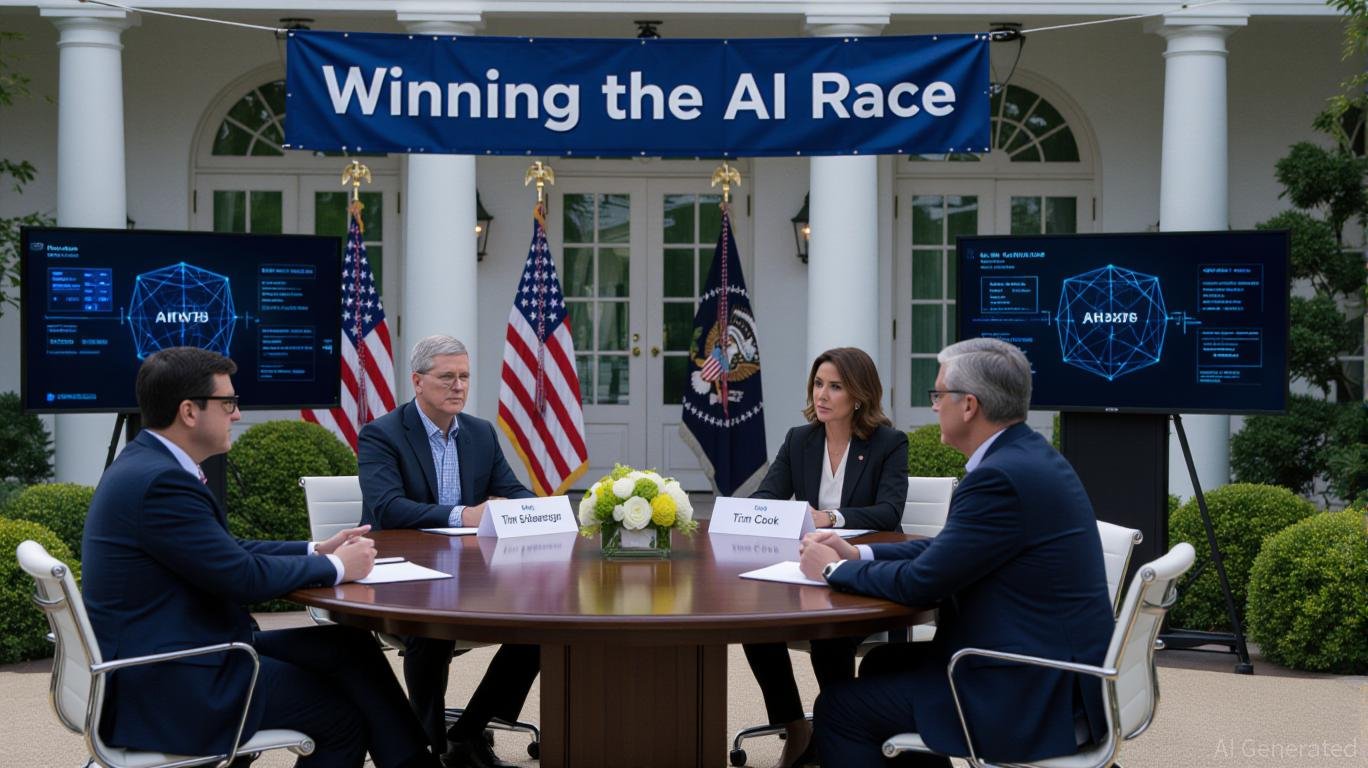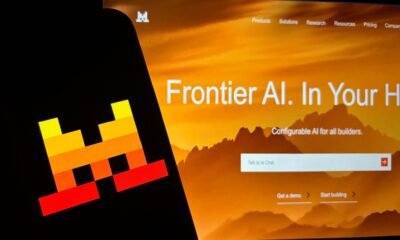Tools & Platforms
Why Tech Giants Must Upskill Society

NEW YORK, NEW YORK – DECEMBER 04: Sundar Pichai, C.E.O. of Google and Alphabet, speaks during the New York Times annual DealBook summit at Jazz at Lincoln Center on December 04, 2024 in New York City. The NYT summit with Andrew Ross Sorkin returns with interviews on the main stage including Sam Altman, co-founder and C.E.O. of OpenAI, Jeff Bezos, founder and executive chairman of Amazon and owner of the Washington Post, former U.S. President Bill Clinton and Prince Harry, The Duke of Sussex, among others. The discussions will touch on topics such as business, politics and culture. (Photo by Michael M. Santiago/Getty Images)
Getty Images
On August 6, 2025, Google CEO Sundar Pichai announced an initiative to provide free access to advanced AI tools and training programs for college students in the US, Japan, Korea, Indonesia and Brazil. This move signals that AI is quickly becoming as indispensable as computers in the early 2000s and the internet in the 2010s. For students, access to AI capabilities is no longer optional but is being made as a necessary part of learning.
College Students to Generate Research Reports with Gemini 2.5 Pro for Free
Google’s new offerings include an array of sophisticated tools. Students can use Gemini 2.5 Pro, an advanced AI model capable of answering questions, generating images, and providing quick help with homework and writing tasks. The platform also features Deep Research, which streamlines the process of gathering in-depth, web-wide information for custom research reports. NotebookLM acts as a personal thinking assistant, helping students organize ideas. Veo 3 allows users to transform text or images into short videos with sound in just eight seconds. Additionally, Jules, an AI coding assistant, offers higher limits for asynchronous coding tasks. Students also enjoy 2 terabytes of storage across Google Photos, Drive, and Gmail.
On top of these functions, Google introduces a new mode called Guided Learning in Gemini, which can show students step-by-step processes in solving a problem via rounds of conversations to help students “understand” rather than giving “answers” direclty.
This array of resources signifies a profound shift: AI is becoming ingrained in education, akin to how digital tools revolutionized learning decades ago. However, more than many other technologies, AI frequently sparked debates over plagiarism and academic integrity. Just a few months ago, a grad student using AI on exams was expelled from the university. Now, the deployment of free AI tools to college students indicates a recognition that AI’s role in education is becoming inevitable. Like the transition from handwritten theses to digital word processing, we can expect that possibly within a year or two, AI will be a routine part of students’ academic workflows, from data analysis and presentations to group projects and writing assignments.
This transformation presents both promising opportunities and notable challenges. On the positive side, democratizing access to AI enables students to learn more efficiently, explore broader and deeper materials, and develop skills aligned with the demands of the future workforce. Google’s integration of career certificate programs alongside these AI tools exemplifies this approach, aiming to equip students with practical skills that will serve them in their careers.
The History of Tech Companies Upskilling Society
Looking back at the computer literacy boom of the 1970s and 2000s, tech giants like IBM and Microsoft played pivotal roles, not just by providing tools and resources but by fostering partnerships with educational institutions. For instance, in 1971, IBM initiated its Faculty Loan Program, under which IBM employees visited colleges training students of color and of diverse abilities. Microsoft initiated the Working Connections program in 1997 in collaboration with the American Association of Community Colleges to develop an IT curriculum serving students with limited resources. These collaborations produced generations of engineers and scientists who fueled industry growth.
This corporate upskilling mirrored, and sometimes sparked, broader open education movements. When MIT launched the OpenCourseWare in 2001, it demonstrated how technology could democratize elite curricula. Later, edX (co-founded by Harvard and MIT) scaled this globally. Recently, MIT just launched a new platform called the MIT Learn to continue this tradition, offering over 12,000 items of free resources in everything from machine learning ethics to cell biology.
Today, Google is well-positioned to play a similar role, leveraging its scale, resources, and industry ties to train the next generation of skilled workers. Google’s extensive infrastructure and established networks afford it a strategic advantage in deploying large-scale, impactful educational initiatives. But AI start-ups such as OpenAI, Anthropic and many more should also join the effort to prepare the next generation with skills needed to succeed in the age of AI. When AI enhances productivity, potentially replacing many entry-level jobs, it becomes vital that the resulting surplus is reinvested into society, creating new opportunities rather than widening inequalities.
Upskilling or Deskilling: the Risks of Overreliance on AI
Nonetheless, the widespread availability of free AI tools raises important questions about their impact on learning. Will dependency on AI diminish students’ ability to think critically, write persuasively, or master foundational skills like coding and logical reasoning? College remains a critical stage for developing these competencies, foundations that underpin careers in law, finance, education, arts, healthcare, technology and public service. If AI replaces too many opportunities for students to engage deeply with writing, problem-solving, and conceptual understanding, we risk cultivating a generation overly reliant on AI, similar to needing a calculator for basic math.
Therefore, AI companies must carefully consider how to deliver tools that truly motivate students to learn and to solve hard problems rather than compromising their curiosity and integrity. Instead of offering free AI functions with minimal guidance, they should collaborate with colleges and even k-12 schools to develop educational programs that foster critical thinking, creativity, and mastery of core skills. The goal should be to empower students to adapt to an AI-driven world, rather than fostering dependence or complacency.
Integrating AI into education offers tremendous promise, but it also demands responsible stewardship. Enterprises, educators, and policymakers must collaborate to ensure AI serves as a tool for empowerment and skill-building. Only then can we prepare a future workforce capable of harnessing AI’s benefits, while maintaining the essential skills such as lucid writing, logical reasoning, critical thinking and ethical judgment.
Tools & Platforms
A Strategic Inflection Point for AI and Corporate Alignment

The Trump administration’s recent AI Action Plan and the high-profile Tech Summit in the newly renovated White House Rose Garden mark a pivotal recalibration of U.S. technology policy. By aligning corporate priorities with federal deregulatory ambitions, the administration is reshaping the investment landscape for artificial intelligence. This analysis explores the strategic implications of this alignment, focusing on how Trump’s policies are redefining risk, reward, and global competitiveness in the AI sector.
Deregulation as a Catalyst for Innovation
The administration’s AI Action Plan, unveiled on July 23, 2025, prioritizes accelerating innovation through regulatory rollbacks. Over 90 federal policy actions aim to remove barriers to AI development, including streamlined permitting for data centers and reduced environmental restrictions on infrastructure projects [2]. For instance, the use of categorical exclusions under the National Environmental Policy Act (NEPA) now expedites data center construction, a move that could unlock billions in private investment. According to a report by Bloomberg, this deregulatory push has already spurred a 20% surge in capital expenditures by hyperscale cloud providers in Q3 2025 [4].
The emphasis on “ideological neutrality” in federal AI procurement, formalized via the “Preventing Woke AI” executive order, further signals a shift in priorities. By mandating that AI models adhere to “truth-seeking” principles, the administration is fostering a market environment where companies like Nvidia and Microsoft—whose open-weight models align with these guidelines—stand to gain significant federal contracts [5]. This creates a dual opportunity: firms that adapt to the new framework may secure lucrative government partnerships, while those lagging in compliance risk marginalization.
Infrastructure and Export-Driven Growth
A cornerstone of the AI Action Plan is the push to build domestic AI infrastructure, including semiconductors and data centers. The administration’s call for a single federal standard—replacing a patchwork of state-level regulations—has already influenced investor behavior. Morgan Stanley notes that tech stocks in the S&P 500 accounted for 80% of the index’s gains in 2025, with AI-related equities outperforming by a 15-point margin [4]. This trend is amplified by the administration’s focus on exporting the “American AI Technology Stack” to allies, a strategy that could expand markets for U.S. firms while countering Chinese influence [3].
However, this infrastructure push is not without risks. Critics warn that reduced environmental oversight could lead to long-term costs, such as energy grid strain and ecological damage. Yet, the administration’s commitment to modernizing the power grid—part of its AI Action Plan—suggests a calculated effort to mitigate these concerns through public-private partnerships [5].
Corporate Alignment and Investor Sentiment
The Trump administration’s summit with tech leaders like Mark Zuckerberg, Tim Cook, and Bill Gates underscores a deliberate effort to harmonize corporate and federal agendas. This alignment has translated into investor confidence: since the plan’s announcement, the S&P 500’s AI-driven gains have surged, with Nvidia’s market cap alone rising by $1.2 trillion in six months [1].
Yet, this optimism is tempered by divergent regulatory pressures. While the federal government promotes deregulation, states like California and New York have maintained stricter AI oversight. This creates a “regulatory arbitrage” scenario, where companies may prioritize federal-aligned strategies to access funding and contracts, even if it means sidestepping state-level safeguards [2]. For investors, this duality presents both opportunities (e.g., scalable AI deployments) and risks (e.g., reputational damage from perceived ethical lapses).
Strategic Implications for Investors
The administration’s focus on global AI leadership—through alliances with like-minded nations and export controls—positions U.S. tech firms to dominate emerging markets. However, the lack of detailed implementation timelines in the AI Action Plan raises questions about execution risks [6]. Investors should prioritize companies with robust supply chains and geopolitical agility, such as semiconductor manufacturers and cybersecurity firms.
Conversely, sectors reliant on state-level regulations (e.g., healthcare AI with privacy mandates) may face headwinds. The administration’s discouragement of state-level AI rules—via funding decisions tied to regulatory climates—could force firms to choose between compliance and profitability [1].
Conclusion
Trump’s Tech Summit and AI Action Plan represent a strategic inflection point, redefining the interplay between corporate innovation and federal policy. While deregulation and infrastructure investment offer clear tailwinds for tech stocks, investors must navigate the tension between short-term gains and long-term risks. The administration’s emphasis on ideological neutrality and global competitiveness suggests a market environment where alignment with federal priorities will increasingly dictate success. For now, the data—and the market—seem to be on the administration’s side.
Source:
[1] The Trump Administration’s 2025 AI Action Plan [https://www.sidley.com/en/insights/newsupdates/2025/07/the-trump-administrations-2025-ai-action-plan]
[2] Tech companies want to move fast. Trump’s ‘AI Action Plan’ [https://www.latimes.com/business/story/2025-07-23/trump-unveils-ai-action-plan]
[3] Trump AI Summit Targets Hardware as Key to US Supremacy [https://www.bloomberg.com/news/newsletters/2025-07-28/trump-ai-summit-targets-hardware-as-key-to-us-supremacy]
[4] Q2 2025 Market Perspective [https://altiumwealth.com/blogs/altium-insights/q2-2025-market-perspective]
[5] Trump Administration Unveils AI Action Plan with … [https://www.mayerbrown.com/en/insights/publications/2025/07/trump-administration-unveils-ai-action-plan-with-implications-for-innovation-infrastructure-and-global-tech-competition]
[6] Inside Trump’s Ambitious AI Action Plan | Stanford HAI [https://hai.stanford.edu/news/inside-trumps-ambitious-ai-action-plan]
Tools & Platforms
AI, lasers and chips: the science and tech of China’s military parade

China’s military parade on Wednesday – featuring the latest AI-powered uncrewed vehicles, laser weapons and missiles – signalled an arms race fuelled by scientific and technological advances.
Artificial intelligence, optics and physics and information technologies have underscored how innovations will shape the future of modern warfare, paving the way for futuristic intelligent systems.
“The parade featured unmanned intelligent systems, underwater combat units, cyber and electronic forces and hypersonic weapons, highlighting the growing capacity of the People’s Liberation Army (PLA) to harness emerging technologies, adapt to the evolving character of warfare, and prevail in future conflicts,” state broadcaster CCTV said.
The weapons on parade featured a “high level of informatisation, intelligence and practical combat capability, showcasing the military’s combat abilities, capabilities in new domains and strong strategic deterrence”, Dong Yongzai, a researcher at a centre under Beijing’s Academy of Military Science, told CCTV.
AI-powered equipment and vehicles
The parade showcased a variety of AI-powered uncrewed equipment.
The land combat formation showed vehicles that can perform reconnaissance, assaults, mine and bomb defusing and squad support, according to CCTV.
Tools & Platforms
Janus Health Joins Cipher Collective as Revenue Cycle Technology Provider in AI-Enabled Healthcare Initiative – geneonline.com
-

 Business5 days ago
Business5 days agoThe Guardian view on Trump and the Fed: independence is no substitute for accountability | Editorial
-
Tools & Platforms3 weeks ago
Building Trust in Military AI Starts with Opening the Black Box – War on the Rocks
-

 Ethics & Policy1 month ago
Ethics & Policy1 month agoSDAIA Supports Saudi Arabia’s Leadership in Shaping Global AI Ethics, Policy, and Research – وكالة الأنباء السعودية
-

 Events & Conferences4 months ago
Events & Conferences4 months agoJourney to 1000 models: Scaling Instagram’s recommendation system
-

 Jobs & Careers2 months ago
Jobs & Careers2 months agoMumbai-based Perplexity Alternative Has 60k+ Users Without Funding
-

 Education2 months ago
Education2 months agoVEX Robotics launches AI-powered classroom robotics system
-

 Funding & Business2 months ago
Funding & Business2 months agoKayak and Expedia race to build AI travel agents that turn social posts into itineraries
-

 Podcasts & Talks2 months ago
Podcasts & Talks2 months agoHappy 4th of July! 🎆 Made with Veo 3 in Gemini
-

 Podcasts & Talks2 months ago
Podcasts & Talks2 months agoOpenAI 🤝 @teamganassi
-

 Education2 months ago
Education2 months agoAERDF highlights the latest PreK-12 discoveries and inventions

















